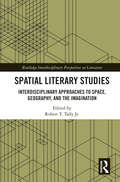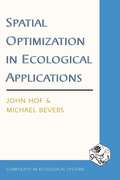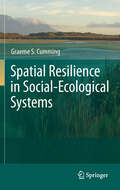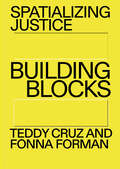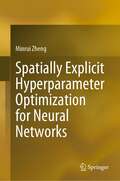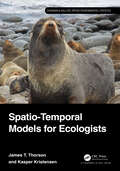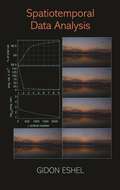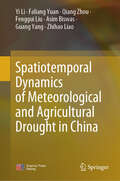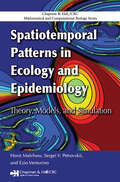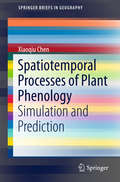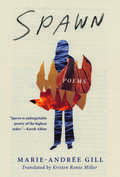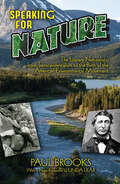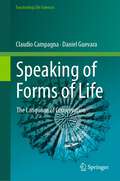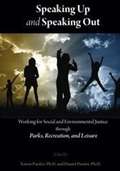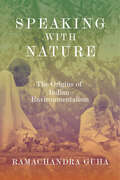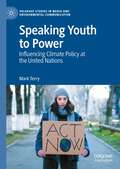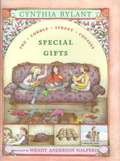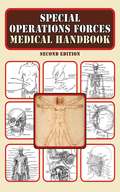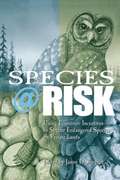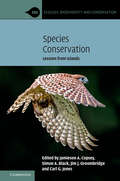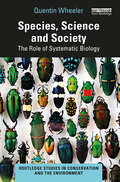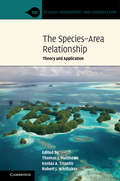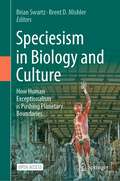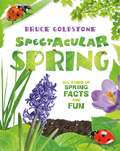- Table View
- List View
Spatial Literary Studies: Interdisciplinary Approaches to Space, Geography, and the Imagination (Routledge Interdisciplinary Perspectives on Literature)
by Robert T. Tally Jr.Following the spatial turn in the humanities and social sciences, Spatial Literary Studies: Interdisciplinary Approaches to Space, Geography, and the Imagination offers a wide range of essays that reframe or transform contemporary criticism by focusing attention, in various ways, on the dynamic relations among space, place, and literature. These essays reflect upon the representation of space and place, whether in the real world, in imaginary universes, or in those hybrid zones where fiction meets reality. Working within or alongside related approaches, such as geocriticism, literary geography, and the spatial humanities, these essays examine the relationship between literary spatiality and different genres or media, such as film or television. The contributors to Spatial Literary Studies draw upon diverse critical and theoretical traditions in disclosing, analyzing, and exploring the significance of space, place, and mapping in literature and in the world, thus making new textual geographies and literary cartographies possible.
Spatial Optimization in Ecological Applications (Complexity in Ecological Systems)
by John Hof Michael BeversWhether discussing habitat placement for the northern spotted owl or black-tailed prairie dog or strategies for controlling exotic pests, this book explains how capturing ecological relationships across a landscape with pragmatic optimization models can be applied to real world problems. Using linear programming, Hof and Bevers show how it is possible for the researcher to include many thousands of choice variables and many thousands of constraints and still be quite confident of being able to solve the problem in hand with widely available software. The authors' emphasis is to preserve optimality and explore how much ecosystem function can be captured, stressing the solvability of large problems such as those in real world case studies.
Spatial Resilience in Social-Ecological Systems
by Graeme S. CummingSpatial Resilience is a new and exciting area of interdisciplinary research. It focuses on the influence of spatial variation - including such things as spatial location, context, connectivity, and dispersal - on the resilience of complex systems, and on the roles that resilience and self-organization play in generating spatial variation. Prof. Cumming provides a readable introduction and a first comprehensive synthesis covering the core concepts and applications of spatial resilience to the study of social-ecological systems. The book follows a trajectory from concepts through models, methods, and case study analysis before revisiting the central problems in the further conceptual development of the field. In the process, the author ranges from the movements of lions in northern Zimbabwe to the urban jungles of Europe, and from the collapse of past societies to the social impacts of modern conflict. The many case studies and examples discussed in the book show how the concept of spatial resilience can generate valuable insights into the spatial dynamics of social-ecological systems and contribute to solving some of the most pressing problems of our time. Although it has been written primarily for students, this book will provide fascinating reading for interdisciplinary scientists at all career stages as well as for the interested public. "Graeme Cumming, central in the development of resilience thinking and theory, has produced a wonderful book on spatial resilience, the first ever on this topic. The book will become a shining star, a classic in the explosion of new ideas and approaches to studying and understanding social-ecological systems." Carl Folke, Stockholm Resilience Centre, Sweden
Spatializing Justice: Building Blocks
by Teddy Cruz Fonna FormanA manifesto calling for a new kind of architecture that confronts social and economic inequality and uneven urban growth.Spatializing Justice calls for architects and urban designers to do more than design buildings and physical systems. Architects should take a position against inequality and practice accordingly. With these thirty short, manifesto-like texts—building blocks for a new kind of architecture—Spatializing Justice offers a practical handbook for confronting social and economic inequality and uneven urban growth in architectural and planning practice, urging practitioners to adopt approaches that range from redefining infrastructure to retrofitting McMansions. These building blocks call for expanded modes of practice, through which architects can imagine new spatial procedures, political and economic strategies, and modalities of sociability. Challenging existing exclusionary policies can advance a more experimental architecture not bound by formal parameters. Architects must think of themselves as designers not only of things but of civic processes, complicate the ideas of ownership and property, and imagine new sites of research, pedagogy, and intervention. As one of the texts advises, &“The questions must be different questions if we want different answers.&” Copublished with Hatje Cantz Verlag
Spatially Explicit Hyperparameter Optimization for Neural Networks
by Minrui ZhengNeural networks as the commonly used machine learning algorithms, such as artificial neural networks (ANNs) and convolutional neural networks (CNNs), have been extensively used in the GIScience domain to explore the nonlinear and complex geographic phenomena. However, there are a few studies that investigate the parameter settings of neural networks in GIScience. Moreover, the model performance of neural networks often depends on the parameter setting for a given dataset. Meanwhile, adjusting the parameter configuration of neural networks will increase the overall running time. Therefore, an automated approach is necessary for addressing these limitations in current studies. This book proposes an automated spatially explicit hyperparameter optimization approach to identify optimal or near-optimal parameter settings for neural networks in the GIScience field. Also, the approach improves the computing performance at both model and computing levels. This book is written for researchers of the GIScience field as well as social science subjects.
Spatio-Temporal Models for Ecologists (Chapman & Hall/CRC Applied Environmental Statistics)
by James Thorson Kasper KristensenEcological dynamics are tremendously complicated and are studied at a variety of spatial and temporal scales. Ecologists often simplify analysis by describing changes in density of individuals across a landscape, and statistical methods are advancing rapidly for studying spatio-temporal dynamics. However, spatio-temporal statistics is often presented using a set of principles that may seem very distant from ecological theory or practice. This book seeks to introduce a minimal set of principles and numerical techniques for spatio-temporal statistics that can be used to implement a wide range of real-world ecological analyses regarding animal movement, population dynamics, community composition, causal attribution, and spatial dynamics. We provide a step-by-step illustration of techniques that combine core spatial-analysis packages in R with low-level computation using Template Model Builder. Techniques are showcased using real-world data from varied ecological systems, providing a toolset for hierarchical modelling of spatio-temporal processes. Spatio-Temporal Models for Ecologists is meant for graduate level students, alongside applied and academic ecologists.Key Features: Foundational ecological principles and analyses Thoughtful and thorough ecological examples Analyses conducted using a minimal toolbox and fast computation Code using R and TMB included in the book and available online
Spatiotemporal Data Analysis
by Gidon EshelA severe thunderstorm morphs into a tornado that cuts a swath of destruction through Oklahoma. How do we study the storm's mutation into a deadly twister? Avian flu cases are reported in China. How do we characterize the spread of the flu, potentially preventing an epidemic? The way to answer important questions like these is to analyze the spatial and temporal characteristics--origin, rates, and frequencies--of these phenomena. This comprehensive text introduces advanced undergraduate students, graduate students, and researchers to the statistical and algebraic methods used to analyze spatiotemporal data in a range of fields, including climate science, geophysics, ecology, astrophysics, and medicine. Gidon Eshel begins with a concise yet detailed primer on linear algebra, providing readers with the mathematical foundations needed for data analysis. He then fully explains the theory and methods for analyzing spatiotemporal data, guiding readers from the basics to the most advanced applications. This self-contained, practical guide to the analysis of multidimensional data sets features a wealth of real-world examples as well as sample homework exercises and suggested exams.
Spatiotemporal Dynamics of Meteorological and Agricultural Drought in China
by Yi Li Guang Yang Asim Biswas Faliang Yuan Qiang Zhou Fenggui Liu Zhihao LiaoThis book explores spatiotemporal analysis and impact assessment of agricultural drought in China and investigates the correlation coefficient between meteorological drought and agricultural drought. It then conducts multivariate frequency analysis of drought events using drought indices and copula functions. It aims to reveal spatiotemporal characteristics and impacts of agricultural drought in China both on vegetation phenology and productivity. The book assesses the performances of drought indices for better predicting multi-year droughts and return periods and drought risk assessment.
Spatiotemporal Patterns in Ecology and Epidemiology: Theory, Models, and Simulation (Chapman & Hall/CRC Mathematical Biology Series)
by Horst Malchow Sergei V. Petrovskii Ezio VenturinoAlthough the spatial dimension of ecosystem dynamics is now widely recognized, the specific mechanisms behind species patterning in space are still poorly understood and the corresponding theoretical framework is underdeveloped. Going beyond the classical Turing scenario of pattern formation, Spatiotemporal Patterns in Ecology and Epidemiology:
Spatiotemporal Processes of Plant Phenology: Simulation and Prediction (SpringerBriefs in Geography)
by Xiaoqiu ChenThis book deals with phenology, the study of recurring biological life cycle stages, and especially their timing and relationships with biotic and abiotic forces. Given the theoretical and methodological innovations involved, the chapters on defining spatiotemporal patterns of plant phenology and constructing daily temperature-based temporal/spatial models and process-based regional unified models will be of particular interest. Helping readers discover and explore plant phenology’s perspectives in terms of spatiotemporal patterns, processes and mechanisms, the book will also equip young scientists and graduate students to understand the causes of spatiotemporal variation in vegetation seasonality.
Spawn (Literature in Translation Series)
by Marie-Andrée Gill Kristen Renee MillerSpawn is a braided collection of brief, untitled poems, a coming-of-age lyric set in the Mashteuiatsh Reserve on the shores of Lake Piekuakami (Saint-Jean) in Quebec. Undeniably political, Gill's poems ask: How can one reclaim a narrative that has been confiscated and distorted by colonizers?The poet's young avatar reaches new levels on Nintendo, stays up too late online, wakes to her period on class photo day, and carves her lovers' names into every surface imaginable. Encompassing twenty-first-century imperialism, coercive assimilation, and 90s-kid culture, the collection is threaded with the speaker's desires, her searching: for fresh water to "take the edge off," for a "habitable word," for sex. For her "true north"—her voice and her identity.Like the life cycle of the ouananiche that frames this collection, the speaker's journey is cyclical; immersed in teenage moments of confusion and life on the reserve, she retraces her scars to let in what light she can, and perhaps in the end discover what to "make of herself".Praise for Spawn:"Spawn is an epic journey that follows the ouananiche in their steadfast ability to hold: rigid, shimmering, hardened to the frigid waters of winter, in all of its capacities of and for whiteness. Here, poems summon a spawn of wonderworking dreams: 'a woman risen up from all these winter worlds, heaped with ice [and] ready to start again'." —Joshua Whitehead, author of Jonny Appleseed"Spawn is unforgettable poetry of the highest order." —Kaveh Akbar, author of Calling a Wolf a Wolf"Gill's poems are like small treasures clutched in buried tree roots, preserving 'the chalky veins' of ancestral memory pulsing just below our modern hustle." —Kiki Petrosino, author of White Blood
Speaking for Nature: The Literary Naturalists, From Transcendentalism To The Birth Of The American Environmental Movement
by Paul BrooksBeginning with Thoreau, nature writers not only have influenced our appreciation of the natural world but also have helped to preserve the American wilderness, from the Maine Woods to Yosemite and the Sierra. Writer and activist Paul Brooks presents narrative portraits of great literary naturalists, offering a 200-year history of the country's movement toward conservation. Profiles of leaders in the fight to protect the environment and safeguard our natural heritage include John Burroughs, John Muir, William Beebe, and many others. A new Foreword has been written for this edition by Linda Lear, author of Rachel Carson: Witness for Nature. "A richly informative book which portrays the nature writers from Henry Thoreau to Rachel Carson who shaped the development of conservation in America." -- San Francisco Chronicle "A brisk and illuminating survey of the naturalists who by their writing moved Americans into the age of ecology." -- The New York Times Book Review "This valuable book reviews the past century of American nature writing from the prose rhapsodies of Thoreau and Muir to the alarm calls of Bernard DeVoto and Rachel Carson . . . writers who have fought bravely and well and have left us a powerful heritage upon which to build." -- Boston Globe"Paul Brooks's gracefully illustrated text, in the very tradition it honors, offers hope that reason and reverence -- the poetry of science -- will prevail." -- Washington Post Book World
Speaking of Forms of Life: The Language of Conservation (Fascinating Life Sciences)
by Claudio Campagna Daniel GuevaraHumans pose an unprecedented threat to life in all its great diversity of forms. The human-induced extinction rate has been compared to “mass extinctions” of the past. But this language masks the fact that the crisis is due to voluntary, and thus, avoidable choices and actions. “Speaking of Forms of Life” shows that at the root of this crisis is the tragic inadequacy of the language predominantly used to represent and address what we are doing, including the language of “sustainable development,” “rights” for animals and the rest of nature, their “intrinsic value,” and conservation of species as “populations.” This talk alienates us from the other living things, from what they actually are, have and do, and it perpetuates the harm and loss. Campagna and Guevara compellingly argue, on rigorous but accessible grounds, that there is an alternative language to guide conservation, in confronting the radically urgent, ethical issues it faces. This is a language with which we are all familiar, mastered by naturalists, from Aristotle to Audubon. It articulates the primary value in life and the standard that must guide how human beings should live, as one form of life, among countless others. This book is a homecoming for those who practice conservation to, above all else, secure a creature’s ability to satisfy the necessities of its form of life.
Speaking Up and Speaking Out: Working for Social and Environmental Justice through Parks, Recreation, and Leisure
by Karen Paisley Daniel DustinWho speaks up for the disadvantaged? Who speaks out for the disenfranchised? Who safeguards the rights of the dispossessed? Speaking Up and Speaking Out explores the role of parks, recreation, and leisure in promoting social and environmental justice.
Speaking with Nature: The Origins of Indian Environmentalism
by Ramachandra GuhaFrom one of the world&’s leading historians comes the first substantial study of environmentalism set in any country outside the Euro-American world By the canons of orthodox social science, countries like India are not supposed to have an environmental consciousness. They are, as it were, &“too poor to be green.&” In this deeply researched book, Ramachandra Guha challenges this narrative by revealing a virtually unknown prehistory of the global movement set far outside Europe or America. Long before the publication of Rachel Carson&’s Silent Spring and well before climate change, ten remarkable individuals wrote with deep insight about the dangers of environmental abuse from within an Indian context. In strikingly contemporary language, Rabindranath Tagore, Radhakamal Mukerjee, J. C. Kumarappa, Patrick Geddes, Albert and Gabrielle Howard, Mira, Verrier Elwin, K. M. Munshi, and M. Krishnan wrote about the forest and the wild, soil and water, urbanization and industrialization. Positing the idea of what Guha calls &“livelihood environmentalism&” in contrast to the &“full-stomach environmentalism&” of the affluent world, these writers, activists, and scientists played a pioneering role in shaping global conversations about humanity&’s relationship with nature. Spanning more than a century of Indian history, and decidedly transnational in reference, this book offers rich resources for considering the threat of climate change today.
Speaking Youth to Power: Influencing Climate Policy at the United Nations (Palgrave Studies in Media and Environmental Communication)
by Mark TerryThis book examines the methods and approaches currently being taken by the global community of youth in influencing environmental policymakers of the United Nations. It is divided into two sections: The Groundswell Approach, exploring the use of social media and mass gatherings aimed at raising public awareness of the issue of climate change; and The Direct Approach, a participatory methodology that encourages collaboration directly with the policymaker and youth in the discussions and creation of progressive climate policy for the world. The book also delivers a detailed analysis of the United Nations’ only database of youth-produced documentary films related to climate change research, impacts, and proposed solutions: the Youth Climate Report, arguing that film is a powerful and effective communications tool for the policymaker. The book proposes two frameworks and explores their in-field applications for successful youth climate activism.
Special Gifts (Fountas & Pinnell LLI Blue #4)
by Cynthia RylantThe cousins spend their winter vacation learning to sew with their neighbor Mrs. White and making gifts for a special celebration with Aunt Lucy and her boyfriend Michael.
Special Operations Forces Medical Handbook
by Department of DefenseThe newest edition of the Special Operations Forces Medical Handbook is perfect and practical for both soldiers and civilians. Nearly 140 comprehensive illustrations show the proper techniques for medical care, from basic first-aid and orthopedics to instructions for emergency war surgery and even veterinary medicine. Questions are listed so that the medic can obtain an accurate patient history and perform a complete physical examination. Diagnoses are made easier with information on the distinctive features of each illness. This straightforward manual is sure to assist any reader faced with a medical issue or emergency.
Species at Risk: Using Economic Incentives to Shelter Endangered Species on Private Lands
by Jason F. ShogrenProtecting endangered species of animals and plants is a goal that almost everyone supports in principle--but in practice private landowners have often opposed the regulations of the Endangered Species Act, which, they argue, unfairly limits their right to profit from their property. <P><P>To encourage private landowners to cooperate voluntarily in species conservation and to mitigate the economic burden of doing so, the government and nonprofit land trusts have created a number of incentive programs, including conservation easements, leases, habitat banking, habitat conservation planning, safe harbors, candidate conservation agreements, and the "no surprise" policy.
Species Conservation: Lessons from Islands (Ecology, Biodiversity and Conservation)
by Jamieson A. Copsey Simon A. Black Jim J. Groombridge Carl G. JonesThis book brings together leading conservation practitioners to reflect on their response to the current global biodiversity crisis, through the lens of island species recovery and management. Initial chapters cover the biological understanding of small population biology and the growing threat of invasive species, while subsequent chapters discuss the management of these threats and the complexity of leading projects within a dynamic and still relatively unknown system. Multiple case studies from islands worldwide illustrate key points, allowing readers to draw on the first-hand practical experience of experienced professionals. This resource will be invaluable to both current and future conservation professionals, helping them to go beyond disciplinary 'comfort zones' and develop, manage and lead projects over extensive timeframes in a way that brings others with them on the journey.
Species, Science and Society: The Role of Systematic Biology (Routledge Studies in Conservation and the Environment)
by Quentin WheelerThis book presents an engaging and accessible examination of the role of systematic biology in species exploration and biodiversity conservation. Our planet and systematic biology are at a crossroads. Millions of species face an imminent threat of extinction, and, with knowledge of only a fraction of earth’s species we are unprepared to respond. Species, Science and Society explains what is at stake if we continue to ignore the traditional mission of systematics. Rejecting claims that it is too late to document earth’s species, that molecular evidence is sufficient and that comparative morphology and the grand traditions of systematics are outdated, this book makes a compelling argument for a taxonomic renaissance. The book challenges readers to rethink assumptions about systematics. Shattering myths and misconceptions and clarifying the role of systematics in confronting mass extinction, it hopes to inspire a new generation of systematists. Readers are given a deeply personal view of the mission, motivations and rewards of systematic biology. Written in narrative style with passion, wit and optimism, it is the first book to question the growing dominance of molecular data, defend descriptive taxonomy and propose a mission to discover, describe and classify all species. Our evolutionary heritage, the fate of society and the future of the planet depend on what we do next. This book will be of great interest to academics, researchers and professionals working in systematics, taxonomy and biodiversity conservation, as well as students with a basic background in biology.
Species, Science and Society: The Role of Systematic Biology (Routledge Studies in Conservation and the Environment)
by Quentin Wheeler- presents an engaging and accessible examination of the role of systematic biology in species exploration and biodiversity conservation - clarifies misconceptions about systematic biology, reimagining it for the 21st Century - proposes an ambitious, planetary-scale project to inventory and make known every kind of plant, animal, and microbe on Earth - challenges the next and present generations of taxonomists to allow molecular data to assume it’s proper place alongside traditional data, to reembrace the fundamentally important mission of systematics - will be of great interest to those researching and working in systematics in botany and zoology, as well as professionals working in taxonomy and biodiversity conservation.
The Species–Area Relationship: Theory and Application (Ecology, Biodiversity and Conservation)
by Thomas J. Matthews Kostas A. Triantis Robert J. WhittakerSpeciesism in Biology and Culture: How Human Exceptionalism is Pushing Planetary Boundaries
by Brian Swartz Brent D. MishlerThis open access book explores a wide-ranging discussion about the sociopolitical, cultural, and scientific ramifications of speciesism and world views that derive from it. In this light, it integrates subjects across the natural sciences, social sciences, and humanities. The 21st-century western world is anthropocentric to an extreme; we adopt unreasonably self-centered and self-serving ideas and lifestyles. Americans consume more energy resources per person than most other nations on Earth and have little concept of how human ecology and population biology interface with global sustainability. We draw upon religion, popular culture, politics, and technology to justify our views and actions, yet remain self-centered because our considerations rarely extend beyond our immediate interests. Stepping upward on the hierarchy from “racism,” “speciesism” likewise refers to the view that unique natural kinds (species) exist and are an important structural element of biodiversity. This ideology manifests in the cultural idea that humans are distinct from and intrinsically superior to other forms of life. It further carries a plurality of implications for how we perceive ourselves in relation to nature, how we view Judeo-Christian religions and their tenets, how we respond to scientific data about social problems such as climate change, and how willing we are to change our actions in the face of evidence.
Spectacular Spring: All Kinds of Spring Facts and Fun (Season Facts and Fun)
by Bruce GoldstoneSpring is a season of beginnings, from blooming flowers to active animals. People spend more time outdoors, days grow longer, and umbrellas pop open as the weather shifts from snow to rain.There's so much to see and do in spring—and this book will prepare you for all of it! With vivid photographs, lively explanations, and creative craft ideas, Bruce Goldstone presents all the fascinating facts that make spring so spectacular.
